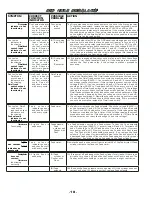
- 22 -
N O T E S :
1.
The Feed Reed Switch is a safety that will not allow the machine to operate if the feed cylinder is not fully
retracted. The Feed Reed Switch is located on the Feed Cylinder. To check that the Feed Reed Switch is
positioned properly, loosen the set screws and put an Ohm meter on terminals 35 and 36 exhaust. Slide
the Feed Reed Switch back and forth until continuity is indicated, then tighten the set screws.
2.
Check that the Air Regulator is set for 80 psi. Mounted on the Dwell Solenoid are two Adjustable Muf-
flers. The top one adjust the speed of the cylinder moving down and the bottom one adjust the speed up.
These mufflers can become restricted or loose. If the machine is sluggish or starts slamming down, adjust
these mufflers accordingly.
3.
The First Pulse Reed Switch is located in the middle of the Dwell cylinder.
4.
To check that the Dwell Reed Switch is positioned properly, loosen the set screws and put an Ohm meter
on terminals 31 and 32. Slide the Dwell Reed Switch up and down until continuity is indicated, then tighten
the set screws.
5.
Mounted on the Feed Cylinder is a Feed Speed Control. The Feed Speed Control adjusts how fast the
Pusher With Pawl assembly moves in and out. If adjusted too fast the pins may be tossed past the tip. If
adjusted too slow the pins will not be placed on the tip.
SYMPTOM
CORRECT
FUNCTION
INDICATOR
POSSIBLE
PROBLEM
ACTION
Vibrator does not
vibrate at all.
N/A
A) Vibrator
Circuit
Breaker.
(A) Check Vibrator Circuit Breaker (Located on the rear of the Control
Console.) (208-/-)
(B) Vibra-
tor Power
Switch.
(B) Check Vibrator Power Switch in the Control Console. (208-/-)
(C) Vibrator
Sensor
(C) The Vibrator Sensor controls the Vibrator Control Relay that supplies
power to the Vibrator Base when there is a demand for weld pins. Check
the indicator light on the Vibrator Sensor goes on and off when the
weld pins go past the Vibrator Sensor. (The Vibrator Sensor is located
on top of the Track Casting) If the indicator light does not go on and
off try to adjust the Vibrator closer to weld pins. If the indicator light
still does not function, replace the Vibrator Sensor.
(D) Vibrator
Control
Relay Board
To check the Vibrator Control Relay, test the voltage (24VAC+/-) at
terminals #T2 and #T5. There should be 24VAC at these terminals
when there is no weld pin at the Track Sensor. If this reading is
correct (Vibrator Sensor), now check the voltage (208-/-) at
terminals #T1 and #T11 on the relay board. When the main power is
on, these terminals should always have voltage. Now check the voltage
(208-/-) at terminals #T3 and #T9. If there is no voltage at
these terminals and the above is correct, replace the Vibrator Control
Relay Board.
(E) Vibrator
Speed
Control.
(E) In the Control Console, check for voltage (208-/-) at terminals
#1 and #3 on the Vibrator Speed Controls. If there is 208-230VAC at
terminals #1 and #3 replace the Vibrator Speed Control.
(F) Vibrator
Coil.
(F) Measure the resistance at the plug (two outside pins) of the Vibrator.
The resistance reading should be approximately 60 ohms. If this reading
is not correct replace the Vibrator Coil.
Vibrator vibrates
but not enough
t o m o v e w e l d
pins.
N/A
(A) Vibrator
Speed
Control.
(A) To test the Vibrator Speed Control place your hand on the Vibrator
Bowl and watch the Vibrator Sensor Indicator. Now adjust the Vibrator
Speed Control from slow to fast and back. If you feel no change in the
intensity on the bowl or see any change in the intensity on the Vibrator
Sensor Indicator, replace the Vibrator Speed Control. If a change in the
intensity is present proceed to the next step.
(B) Vibrator
(B) Turn the power off and remove Vibrator Bowl. Now remove the Vibrator
Shroud and inspect the springs (leaf springs) and weldments for any
damage. If there is no apparent damage proceed to the next step.
(C) Vibrator
adjustment.
(C) To adjust the Vibrator Base loosen the setscrews on the side of the
Vibrator Base. Now locate the two adjustment bolts under the Vibrator
Base. Turn both adjustment bolts in the same direction at very small
increments. If the problem does not improve repeat the procedure in the
opposite direction. (The top of the Vibrator Coil should be approximately
1/64 of an inch or less from Vibrator Base Top Plate) If this procedure
does not improve problem replace Vibrator Springs.
V I B R AT O R P R O B L E M S



































